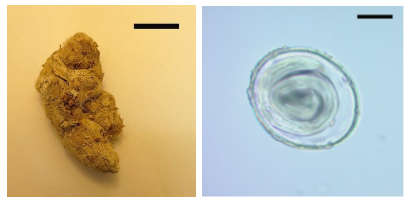A team of Argentinian scientists from the National Council of Scientific and Technical Research (CONICET) made the discovery after studying a coprolite taken from a rock-shelter in the country’s mountainous Catamarca Province, where the remains of now extinct megafauna have previously been recovered in stratigraphic excavations.
Radiocarbon dating revealed that the coprolite and thus the parasitic roundworm eggs preserved inside dated back to between 16,570 and 17,000 years ago, towards the end of the last Ice Age.
At that time, the area around the shelter at Peñas de las Trampas in the southern Andean Puna was thought to have been wetter than today, making it a suitable habitat for megafauna like giant ground sloths, and also smaller herbivores like American horses and South American camelids which the pumas may have preyed on.

Ancient mitochondrial DNA analysis was used to confirm the coprolite came from a Puma (Puma concolor) and that the eggs belonged to Toxascaris leonina, a species of roundworm still commonly found in the digestive systems of modern day cats, dogs and foxes.
[ad_336]
The study, published in the journal Parasitology, explains that the extremely dry, cold and salty conditions which took hold at the Peñas de las Trampas site since the onset of the Holocene would have helped to reduce the breakdown of the DNA, allowing it to be preserved.
Led by Romina Petrigh and Martín Fugassa, the study was carried out by an interdisciplinary team including archaeologists and biologists and is part of a project that views ancient faeces as important paleobiological reservoirs.
Dr Petrigh, from the National University of Mar del Plata and CONICET, said: “While we have found evidence of parasites in coprolites before, those remains were much more recent, dating back only a few thousand years. The latest find shows that these roundworms were infecting the fauna of South America before the arrival of the first humans in the area around 11,000 years ago.”
She added: “I was very happy when I discovered how old this DNA was. It’s difficult to recover DNA of such an old age as it usually suffers damage over time. Our working conditions had to be extremely controlled to avoid contamination with modern DNA, so we used special decontaminated reagents and disposable supplies. Several experiments were performed to authenticate the DNA sequences obtained and the efforts of the team of researchers who participated was essential.”
The discovery marks a number of firsts: it represents the oldest record of an ancient DNA sequence for a gastrointestinal nematode parasite of wild mammals, the oldest molecular parasite record worldwide, and also a new maximum age for the recovery of old DNA of this origin.
[rand_post]
For Dr Petrigh, the findings also cast light on both the past and the present. She said: “This work confirms the presence of T. leonina in prehistoric times, presumably even before that of humans in the region, and it represents the oldest record in the world. The common interpretation is that the presence of T. leonina in American wild carnivores today is a consequence of their contact with domestic dogs or cats, but that should no longer be assumed as the only possible explanation.
“Our aDNA studies have also confirmed the presence of pumas in the southern Puna at the end of the Pleistocene. This has significant implications for the natural history of the region, as well as for inferring the ecological context immediately before – as far as is known – the first human explorers ventured into the area.”
She added: “The large number of eggs of T. leonina and its larva state in the puma coprolite analysed here indicate the high infective capacity of this parasite, involving a high risk for carnivores and for humans.”